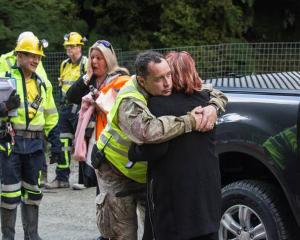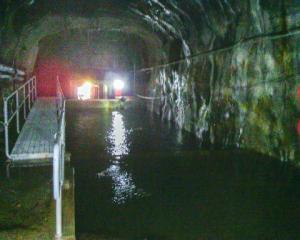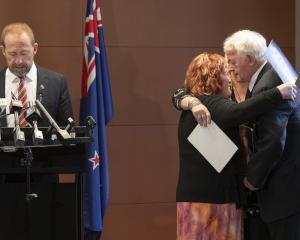Air in the Pike River coal mine is toxic with combustible methane and carbon monoxide and still too dangerous to send in a rescue crew for the 29 trapped miners, say police, after a bore drill finally broke through to the mine this morning.
The 162m bore, which started drilling on Sunday, hit a 5m-wide roadway in the mine about 7am and was met by a reasonable flow of warm air, Pike River Coal chief executive Peter Whittall told a press conference this morning.
However, the air was low in oxygen and high in carbon monoxide, methane and overnight gas samples from a different source were "off the limit".
He could not comment on whether the levels were survivable for the 29 miners, who have been trapped in the West Coast mine since the explosion there on Friday.
Authorities now say hope is diminishing of finding the men alive. Searchers were planning for both the most positive outcome of find all 29 alive, and also the "most unpleasant job of recovery".
Despite increasing calls for a rescue team to be sent into the mine, the man in charge of the rescue operation, police Superintendent Gary Knowles, repeated his message that the mine could still spontaneously explode, and he was not going to put further lives at risk.
Overnight gas samples showed the levels of methane and carbon monoxide were "off the limit", he said.
A fire underground has no relevance to a burning building, he said in answer to a question posed about whether firefighters would have waited so long before entering the World Trade Centre just after aircraft crashed into it 2001.
"The teams want to go in but they can't and to have any reference to 9/11 is not appropriate."
Mr Knowles said he understood the frustration and anger in the community, but the rescuers were working as a team and making decisions on expert advice.
He defended the decision not to enter the mine straight after blast.
It was major event and no one would have known anything about the environment in the mine, but it could be assumed it was extremely hazardous, as it was now, five days after the blast, he said.
Robots were being sent in because in the event of a second explosion, it would mean just the loss of a robot, not a person, the media was told.
This morning a Defence Force robot had reactivated and managed to make it 1km into the mine, where it captured footage of a discarded cap lamp, thrown down by one of the survivors, Russell Smith, as he ran for safety.
Mr Whittall said the lamp was encouragingly and surprisingly still burning, which meant that if the 29 were still alive, they might have light.
Officials were assessing further footage from the robot, and it would be shown to families first before being released to media.
Meanwhile, a second Defence Robot was in the tunnel and its batteries were due to expire this morning.
Mr Knowles said a third specialised robot, a "very large beast" from Australia, would be taken to the mine today to be readied to possibly be sent down the mine.
Another specialist robot, from the US, will arrive in the country tomorrow.
Mr Whittall said this morning's session with the miners' families was sobering again.
While there are still a number of families obviously frustrated with the decision-making process, there was a large understanding among the group that the gases being found from the bore line and other factors were "making their hopes diminish and making it more difficult for them to hold that hope that all 29 of those guys are waiting for us as we hoped on day one and I think we are all coming to that realisation now".
That did not mean that miners were not alive, he said.
"I certainly hope that the guys are waiting down there, and I certainly hope I get to see them again and I certainly hope that as many of them as we can get out will be got out safely and well."
Earlier, Lawrie Drew, the father of one of the miners says he walked out of a briefing with families today because of "PR (public relations) rubbish".
Mr Drew spoke to media before drilling of a 162m bore hole was completed about 9.30 this morning.
"I walked out because to me it's the same PR rubbish," Mr Drew, whose son Zen, 21, is underground, said.
Families had raised questions including how rescue services were "getting rid of the gas" and the progress of the robots, he said.
However he said many of their questions remained unanswered and they had no more information than what was reported in the media.
Mr Drew told NZPA families of those men trapped were upset they were not allowed to wait at the mine and anger in the community was growing.
"We want to be on-site but we are told it's a safety issue so we can't go there," he said.
The grim reality was driven home yesterday for the anxious families of Pike River miners as they were shown for the first time CCTV footage which demonstrated the power of the blast.
The footage showed dust and debris being expelled from the mine entrance, probably about 2km from where the explosion happened, for more than 50 seconds.
The footage, which Pike River Coal chief executive Peter Whittall said demonstrated the type of blast and the dangerous situation came on top of yesterday's message from police - the situation was getting ''bleaker by the hour, bleaker by the day''.
Meanwhile, some families of the 29 missing miners have been expressing anger at the lack of a rescue attempt.
One family told Campbell Live they questioned the leadership of the officer in charge of the operations, Tasman police district commander Superintendent Gary Knowles, and said they knew mines rescue team members who wanted to go in right now.
But police commissioner Howard Broad defended police handling of the operation.
He said the operation was extremely challenging for police, and fully supported the way it had been run so far.
The mine was seriously volatile and police had a responsibility to try to save lives not put more at risk.
Supt Knowles and mines rescue team leader Trevor Watts both said yesterday there was so far no chance of anyone going into the mine until police could guarantee their safety.
Supt Knowles last night described the situation as ''bleak and grave''.
''We have to understand the risk of a second explosion is real.''
There had been no communication with the 16 miners and 13 contractors since the explosion in the Greymouth mine on Friday afternoon.
However, a camera had been lowered into a fresh air base in the mine, which miners could retreat to if needed.
It had shown some minor damage to the area, but no sign anyone had been there since the blast and no signs of life.
A tube that gathered gas from multiple sample points had been rolled out and was being hooked up to continuous analysers.
Toxic-gas levels remained variable, Mr Whittall said.
''You can understand that having briefed the families, they are extremely frustrated that we can't go underground, but that frustration is shared also by the rescue teams and the mine rescue staff.''
He said police were continuing plans for a rescue, but as time went on, the likelihood of this happening was ''diminishing''.
''We have to be frank about the situation.''
Extra rescue equipment from Australia arrived yesterday.
Minister of Police Judith Collins said she had spent the day with police and family members.
''The police have been, in my opinion, doing an excellent job in an extremely tiring and difficult situation.''
Mr Broad said it was an extremely challenging operation for the police.
''As the situation continues, the situation for those who are below ground is bleak and gets bleaker by the hour, by the day.''- with NZPA/NZ Herald











